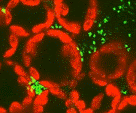Plant Pathology Department
Document Type
Article
Date of this Version
9-1988
Abstract
Plaque-forming viruses of the unicellular, eucaryotic, exsymbiotic, Chlorella-like green algae strain NC64A, which are common in the United States, were also present in fresh water collected in the People's Republic of China. Seven of the Chinese viruses were examined in detail and compared with the Chlorella viruses previously isolated in the United States. Like the American viruses, the Chinese viruses were large polyhedra and sensitive to chloroform. They contained numerous structural proteins and large double-stranded DNA genomes of at least 300 kilobase pairs. Each of the DNAs from the Chinese viruses contained 5-methyldeoxycytosine, which varied from 12.6 to 46.7% of the deoxycytosine, and N6-methyldeoxyadenosine, which varied from 2.2 to 28.3% of the deoxyadenosine. Four of the Chinese virus DNAs hybridized extensively with DNA from the American virus PBCV-1, and three hybridized poorly.


Comments
Published in APPLIED AND ENVIRONMENTAL MICROBIOLOGY, Sept. 1988, p. 2170-2173 Vol. 54, No. 9 0099-2240/88/092170-04$02.00I0 Copyright © 1988, American Society for Microbiology. Used by permission.